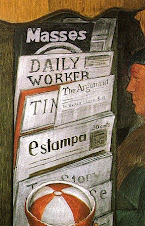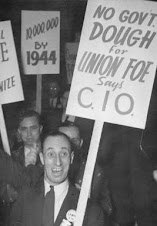Published Aug 10, 2011 7:24 PM
From: Workers World
The downgrade of U.S. government credit and the gyrations of the stock market signal greater budget cuts, another downturn in the economy, and more unemployment and suffering unless there is a strong, mass fightback.
Now is the time to fight for jobs, stop layoffs and foreclosures, defend Social Security and other entitlements under attack, and rebuff the bosses’ attempts to unload the deepening crisis of the profit system on the backs of the workers.
The downgrading of Treasury bonds by Standard & Poor’s credit agency from AAA to AA+ was a message from a section of the bankers and bondholders that they want deep cuts in Social Security, Medicare and Medicaid.
The downgrading had very little to do with the immediate credit worthiness of the U.S. government. It was all about budget cuts. It was a message to the political parties that Wall Street is not satisfied with the debt-ceiling deal that promised only $2.1 trillion in cuts and was too light on entitlements, in their view. The message was mainly to the Democratic Party, but perhaps also to the Tea Party for being so tactically rigid that it failed to seize upon Obama’s concessions on entitlements.
S&P downgrade all about entitlement cuts
All rating agencies depend on payment by the banks for their services. The S&P rating agency announced months ago that it wanted at least $4 trillion cut from the deficit — and that cuts in entitlements were the key to achieving that goal. Republican speaker John Boehner and President Barack Obama were working on just such a deal when it was broken up by the ultra right and the Tea Party.
S&P made this clear. In their statement to the government explaining the move, they wrote that the downgrade was due to their “pessimism” about the prospect for deeper cuts.
They said they lowered the U.S. long-term rating because they believe that “prolonged controversy over raising the statutory debt ceiling” indicates that “further near-term progress on containing growth in public spending, especially on entitlements,” will be contentious. It said that what the Congress and the administration agreed to “falls short of the amount we believe is necessary” to achieve financial stability in the next decade.
More explicitly, they complained that “the plan envisions only minor policy changes on Medicare and little change in other entitlements,” whose “containment” they regard as “key to long-term fiscal sustainability.”
Just to emphasize that the downgrade was a political attack on entitlements, the statement said that “We view the federal government’s ... monetary credit attributes, which form the basis for the sovereign debt rating, as broadly unchanged.”
In other words, the financiers behind S&P are worried that if the government continues to fund the people’s needs there may not be enough money in the future to pay the millionaire and billionaire bondholders and bankers their interest.
Debt-ceiling struggle a political war by the right wing
The debt-ceiling crisis was purely political in nature. The ultra-right Tea Party forces and the more traditional right-wing conservatives of the Republican Party have been in a bloc, waging a political war trying to cut back, if not destroy, Social Security, Medicare and Medicaid, and to undermine President Obama. As in any war, the right seized upon a point of advantage — the legislative requirement that Congress has to approve the debt ceiling of the government. They held entitlements hostage, threatening to force the government to default up until the final hour of the deadline.
The downgrade by Standard & Poor’s was a pure act of retribution because the debt-ceiling deal did not cut deep enough. S&P included a threat of future downgrades if the politicians don’t cut more.
Stock market plunge and fear of “double dip”
The subsequent plunge in the stock market, while affected by the downgrade, was fundamentally a reaction to the threat of a “double dip” or a new downturn in the capitalist economy.
The slowing growth of the U.S. economy — a growth rate of only 0.8 percent in the first half of this year — means that unemployment has gone up, in spite of the official government statistics declaring that unemployment declined in the month of July from 9.2 percent to 9.1 percent.
Everyone knows that this is a vast understatement of true unemployment. There are at least 30 million workers either unemployed, under-employed or who have dropped out of the workforce altogether.
Cutting the government budget on spending for services, entitlements, public projects and the like only promises to aggravate the economic crisis in the U.S.
In Europe, the same process is gaining momentum. Greece, Portugal and Ireland have already been bailed out by the European Central Bank and the IMF. Now, Italy and Spain, much larger economies, are in crisis. The 90 largest banks in Europe hold $425 billion in Italian government bonds alone. U.S. banks hold $14.3 billion.
The bankers of Europe are demanding gigantic budget cuts from the indebted European countries as the price of a bailout. This will drag down the already slowing economies of Europe.
Bailing out banks, austerity aggravate economic crisis
The capitalists and their politicians are in a contradiction that has no way out. Because of the economic crisis, government revenues have fallen and the bankers’ interest payments are being put at risk. The governments are stepping in to guarantee the bankers’ payments.
But in order to guarantee the bankers their interest, the governments have to cut back spending. Cutting back spending on the people means the workers have less money in their pockets and the economic crisis deepens.
In order to guarantee the banks their pound of flesh, the economic crisis must be made worse by austerity measures. That is what was behind the debt-ceiling struggle. That is what is behind the European debt crisis. The only way out of this vicious cycle is to fight the banks and bondholders and put jobs and workers’ needs first.
New layoffs that would come in the wake of a new capitalist crisis could threaten a collapse. A financial crisis in Europe that spread to the U.S. could trigger global crisis. All these calculations were part of the wild sell-off of stocks.
From capitalist impasse to downturn
The working class must take these warning signals to heart.
For the past two years of so-called “recovery,” the capitalist system has been in a state of impasse. It has been held up from crashing by massive government bailouts of the banks and government spending in general. That is the basis of the debt crisis, not only in the U.S. but in Europe and Japan. While there was no further downturn, the capitalist economy was unable to grow at anything but a snail’s pace. While the corporations have been piling up profits, not a dent has been made in the mass unemployment.
Now the profit system is in danger of sliding from the impasse to a downturn. The bosses have invested in job-killing technology. They have speeded up workers, forced them to work every single second they are on the job, cut their hours to the bone — making them work part time or be temporary workers. Production goes up, but with fewer and fewer workers.
The economy is now nearing the same level of Gross Domestic Product that it was at before the crisis, but with 10 million fewer workers on the job. This means fewer and fewer workers are producing more and more output and services in less and less time for lower and lower wages. All in order to increase profits. The profit system itself is in crisis. And the workers are being asked to suffer. There is no way out of this contradiction on the basis of the capitalist profit system.
Calling upon the capitalists to create jobs when they don’t need more workers is an illusion. The only way to create jobs right now is for government to launch a huge jobs program. Which is exactly what the government refuses to do, given the obsession in the capitalist establishment about cutting spending and deficits.
Need a mass fight for jobs
Capitalist commentators of all types are aghast at the prospect of a new crisis arising in a situation of already-existing long-term mass unemployment. The demand for a jobs program is beginning to take on momentum even from bourgeois voices — from Times op-ed writer Paul Krugman to MSNBC news show host Chris Matthews, and many more.
President Obama has been virtually silent on a real jobs program that can begin to put the millions upon millions of workers back to work. And now there is the threat of a greater unemployment crisis.
The AFL-CIO leadership is beginning to stir on the question and has called for demonstrations around the country in early October. Other forces are joining in the call.
This is a positive, if long overdue, step. However, the working class, the community, students and all who need jobs and are affected by unemployment, directly or indirectly, need to mount a rank-and-file, militant movement to fight this economic crisis.
The message of fightback must be carried to work places, community centers, housing projects, churches and street corners in working-class areas, among all races and nationalities, to build a fighting movement. City halls, statehouses and the federal government as well as corporations must feel the pressure and the anger of the people.
The capitalists are sitting on trillions of dollars in cash. But they won’t hire, are lowering wages and are getting ready to fire more workers if the economic slowdown turns into full-scale contraction. The banks are getting hundreds of billions of dollars in interest payments from governments at every level. The Pentagon and military corporations are getting trillions of dollars to pay for three wars.
Those funds should be used to pay for jobs programs and social needs, not to further enrich the already super-rich.
Socialist fighters, trade union militants, community activists, radicals and progressive organizers must come together as a matter of urgency to build a national fightback movement to combat the crisis.
In the 1930s the Unemployment Councils organized workers and tenants under the slogan “Don’t Starve, Fight!” They had a program for jobs and income. Today’s movement needs a similar fighting approach and a determination to organize at the grassroots level for struggle.
It is necessary for the movement to win victories at whatever level is possible. The program can include the fight for jobs, above all, in the midst of the worst capitalist crisis since the 1930s. But it can also include defending unions, collective bargaining and the rights of undocumented workers; it can fight for food, food stamps and housing; it can oppose foreclosures and evictions, budget cuts and school closings. In other words, it can defend the interests of the workers and oppressed wherever they are under attack.
Subscribe to:
Post Comments (Atom)










































No comments:
Post a Comment